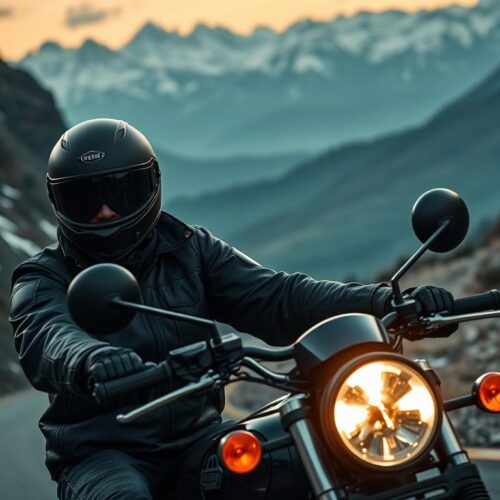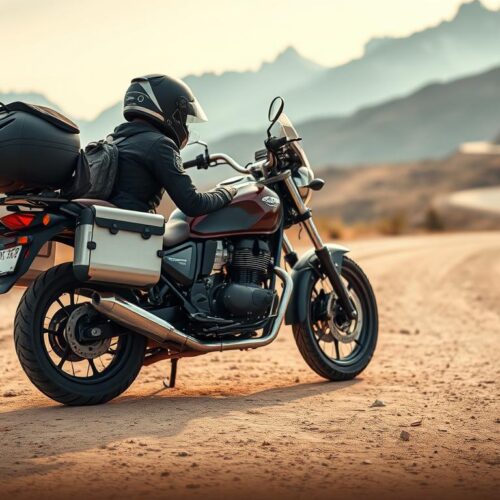Riding long distances on a motorcycle is thrilling. Yet, it brings challenges, especially with fatigue. When you’re on long roads, knowing how to handle motorcycle fatigue is key. This ensures your safety and well-being. Riding a motorcycle requires more from you than driving a car. Because of this, the risk of getting tired is greater. This part will show you how to prepare and stay sharp. The aim is to keep you refreshed. And it will help lower the chances of getting tired. It also boosts your safety on the road.
Understanding Motorcycle Fatigue
Motorcycle fatigue comes from both physical work and things like wind and noise. Riders often miss how important these factors are. This oversight can cause problems on long rides. It’s crucial to watch for early signs of fatigue like feeling sleepy or physically tired.
When you find it hard to focus, your eyelids feel heavy, or your muscles get stiff, it’s a sign you need a break. Spotting these signs of fatigue early is important. It helps you adjust your ride or take breaks to avoid getting too tired.
To manage fatigue, try taking short breaks each hour, stretch, or do some light exercise. Knowing how to handle these factors helps keep you sharp and physically fit. Make sure to put your safety first by noticing when you begin to feel tired. This helps you make smarter choices while riding.
The Importance of Preparation
Preparation is key to a great long-distance ride. It makes you confident and keeps you safe on the road. First, plan your route well. Use GPS and maps to not just pick your way but also find places to rest, refuel, and enjoy the view.
Balance your time between going fast and enjoying the scenery. This mix makes your ride better. Also, always check the weather. It helps you choose the right gear and clothes for different conditions.
Don’t forget to look for road closures or construction work. Knowing the terrain helps you make smart choices while riding. This ensures your trip is both safe and fun. Good preparation is a must for a safe and enjoyable journey.
Choosing the Right Gear
When you’re planning long motorcycle rides, picking the right gear is key for your well-being. High-quality gear boosts safety and comfort. Items like padded gloves and jackets, geared for long rides, help fight off wind and vibration fatigue. This lets you enjoy your ride more.
Don’t overlook a good helmet. It keeps you safe and cuts down on wind noise, making rides more pleasant. A helmet that fits well means less neck strain. Choosing the right gear makes long trips less tiring and more enjoyable.
Here’s a look at some motorcycle gear that can make your ride better:
| Gear Type | Benefits | Recommendation |
|---|---|---|
| Padded Gloves | Reduces vibration strain | Look for brands like Alpinestars or Held |
| Riding Jacket | Wind protection, injury prevention | Consider options from Dainese or Rev’It |
| Helmet | Safety, comfort, noise reduction | Choose quality from Shoei or Arai |
Staying Hydrated on the Road
Staying hydrated is key when going on long motorcycle rides. Dehydration can cause fatigue, loss of focus, and slow reactions. While riding, the combination of sweating and dry air can deplete your body’s water.
To stay properly hydrated, choose water or drinks with electrolytes. Avoid sugary drinks as they can lead to sudden energy drops. It’s important to know the signs of dehydration, like dry mouth and feeling tired. These signs mean you need to drink more water.
Taking Breaks: How Often and How Long?
Taking breaks on long motorcycle rides is crucial. You should stop every 60 to 90 minutes. This avoids drowsiness and keeps you sharp and comfortable. Regular breaks tackle fatigue, letting you stretch and drink water.
Make a plan for your breaks. This ensures they really help your ride. Find safe and comfy places to get off and move a bit. Moving helps with blood flow and keeps you alert. Here are some tips for break time:
- Choose well-lit and well-traveled areas for your stops.
- Engage in stretching exercises to relieve muscle tension.
- Hydrate adequately to keep your endurance levels high.
- Consider short walks to further boost alertness and comfort.
By planning breaks and following these tips, you can make your rides better and enjoy the road more.
The Power of Nutrition
Nutrition is key to battling fatigue on long motorcycle trips. Focus on foods that boost energy to keep you going. Include snacks like nuts, seeds, and protein bars.
They are packed with nutrients. These keep you sharp and full of energy while you ride.
Avoid snacks that are bad for motorcyclists. Candy bars or soda give a quick energy spike but soon leave you tired. Choose snacks that keep your energy up longer.
Keeping a balanced diet is crucial, especially before and during rides. Eating right makes a big difference in how you perform and enjoy your trip. Make wise food choices to improve your ride.

Riding Techniques to Reduce Fatigue
Learning effective riding techniques can make long rides more comfortable. The right body position is key. It allows for better weight distribution, which eases muscle and joint strain. This way, you can control your bike better and feel less tired.
Using windshields and fairings can also help a lot. They cut down wind resistance, so handling your motorcycle becomes easier. You’ll have less strain from wind, letting you focus on the road. This means you can enjoy your ride more without getting tired quickly.
Adding lightweight gear to your riding outfit is another smart move. Light clothes and protective equipment make rides more pleasant. You can travel farther without feeling heavy. Use these tips to stay energetic and reduce fatigue while riding.
Mindfulness and Mental Preparedness
Being mentally prepared is key to fighting off tiredness on long bike rides. Mindful riding techniques can make your trip better. When you focus on your breathing, your mind clears, and you stay sharp.
This attention helps you notice everything around you and any small changes. Spotting when your thoughts wander off can remind you to rest. This alertness is key to keeping your energy up and avoiding tiredness.
Mindfulness isn’t just about safety; it also makes riding more enjoyable. It helps you connect more with your ride.
Many bikers find that short mindfulness practices really help. Appreciating the scenery or listening to your bike can keep you focused. Staying present makes your ride peaceful and meaningful, improving each trip.
Physical Fitness for Motorcycle Riders
To handle long rides, staying fit is key. Exercising regularly boosts your endurance. It helps you enjoy longer journeys without getting tired. You should do exercises that make your core strong and increase stamina. Activities like biking or jogging are great for this.
Don’t skip stretching before you ride. It helps prevent sore muscles and reduces tiredness. Doing stretches before and after riding makes a big difference.
- Neck stretches: Helps relieve tension from helmet use.
- Shoulder rolls: Loosens up tight shoulder muscles.
- Lower back twists: Aids flexibility, essential for long hours on the bike.
Motorcycling needs a fit body. Getting stronger not only boosts how well you ride but it also makes longer trips more comfortable. By working on both strength and flexibility, you’ll find more joy in riding.

Utilizing Technology to Combat Fatigue
Today, using tech can really improve long motorcycle trips. GPS helps you plan your route smartly, showing the best places to rest. This saves time and helps you take breaks when you need them. Taking breaks is key to stay sharp and energized.
Ride tracking apps are super useful for keeping an eye on how much you ride. They look at how long you’re on the road and tell you about your tiredness. These apps warn you when it’s time to rest. This keeps you safe and makes your trip more fun. With these tools, you make smart choices for a better ride.
Knowing When to Call It a Day
Embarking on motorcycle journeys requires awareness of fatigue for your safety and fun. It’s crucial to notice your body’s signals, like focus issues or slow reactions. These signs usually mean you should take a break or stop riding for the day.
Knowing your limits enhances your rides. You might want to keep going, but it’s key to stop when tired. Not taking a break can lead to unsafe conditions for you and others.
Riding is meant to be fun. Caring for your well-being by acknowledging tiredness and respecting your boundaries makes rides safer and more enjoyable. So, when you’re feeling tired, listen to the signs and take the necessary steps.




